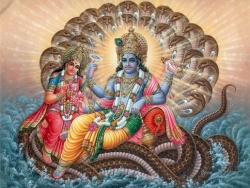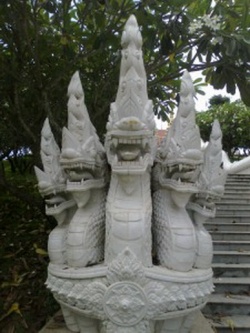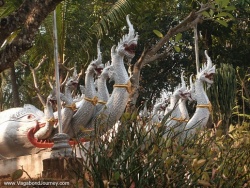Naga' Worship in India and South East Asia by by Krishnaraj
In Indian philosophy the paradigmatic character of the union of opposites [ or, as I sometimes like to say- the wholeness of the result of the dialectic process] constituted one of the most significant characteristics of Indian religious Thought long before it ever became an object of systematic theology.
For example; The Aitareya Brahmana states that the serpent Ahi Budhnya is invisibly what Agni, [the 'furious serpent'] is visibly. In other words, the serpent is a virtuality of Fire, whereas darkness is nonmanifested Light. Again, when the sun rises at dawn, he 'frees himself from night …just as Ahi frees himself from his skin'.
It is in India where we again meet the significant divine serpent in many aspects. In India the cobra has long been considered sacred, and even those cobras used by 'snake charmers' are not injured in any way, not defanged, and when they are used for while they are safely returned to the wild. The "Naga" which is the divine aspect of the cobra is found in both Hindu and Buddhist traditions. In some passages, King Varuna is regarded as being among the most preeminent of the Nagas, and he is included in the discussion of these mythical divine serpents. [Mahabarata 1.26.1. and 25.4] The 'Naga' is a divine serpent who is a son of Kadru, the daughter of Daksha.
The word Naga is a Sanscrit word which means "serpent". Nagas are believed to live in palaces [[[Wikipedia:Patala|Patala]]] in the underground city Bhogavati. They are considered the Protectors of springs, wells and rivers. They bring rain [ similar to the Chinese Lung dragons) and therefore fertility, but can also bring disasters such as floods and drought. In Malay myths Nagas are many-headed Dragons of enormous size. On Java and Thailand, the Naga is a serpent-God, a ruler of the netherworld who possesses much Wealth. In Java they are also called Sesas. In Thailand the Naga can have five heads, much like the Hindu Naga Kanya.
In Mexico we find the word "Nagal" which describes a class of serpent guardian spirits. The avenue leading to the main temple at Ankhor Wat is lined with seven-headed Nagas. The Chinese claim to be able to speak Naga-Krita, the Language of the serpentine gods. For a place that has no serpents, Tibet, the Naga are still known in a symbolic sensand are called "Lu' which is the Tibetan translation of " Naga". For example Nagarjuna is called Lu-truh in Tibet.
To begin; the God Vaskul is the Naga-God of Mount Kailasha, which is also deemed to be the home of the God Shiva, on-third of the Trinity of Brahma aspects. We have pictorial and statuary representations showing snakes around Shiva's neck. These are Naga bushana and they symbolize Death, the Power of which Shiva is beyond, and which he controls. They also represent that energy coiled at the base of the spine which yoga practitioners say is the base for all self-realization.
The Naga represents cosmic Power; they are a manifestation of the Vedic God Agni, or Fire, and as such becomes the 'fierce spirit' who is the guardian. The cobra/Naga is a mount of Vishnu and as such represents Knowledge, Wisdom and eternity. As Vishnu sleeps on the cosmic ocean, he sleeps on the coiled serpent on the primordial waters. Two serpents with downward and upward movement represent the divine sleep and divine Awakening. The Naga and Nagni are serpent kings and queens, which are divine in their own right. They are depicted as either fully human, fully snake, humans with cobra heads and hoods, or as humans from the waist upwards and snake below that.
The Naga as a God is widespread and significant in all of Southern Asia. As far away as the Malay peninsula we find Raja Naga, or King Naga. Who is the king of all of the many sea snakes which populate the area. In India the chief function of the Naga is apparent in temple architecture; they guard the doors.
The Great Naga Kanya, the most common friend/companion of Vishnu is this latter Form. Naga Kanya can also be seen with nine serpent heads with expanded hoods. As the great God Vishnu sits his head and shoulders are protected by these nine serpent heads . Some say that this multiheaded snake is an animal counterpart of the sleeper himself.
Vishnu, the preserver aspect of the Trinitarian Brahma principle, is recognized as one of the most important and most revered of the deities of the Hindu pantheon. He is most often depicted as reclining on a the coils of the great serpent. The Great Naga, Ananta [ the 'endless'], also called Sesha. Ananta has 1000 hooded heads which Form a canopy for Vishnu.. Ananta represents the cosmic ocean.
The Symbol for water, in Hindu mythology, is the serpent (naga). So that, not only the gigantic anthropomorphic Form and the boundless elemental sea are Vishnu, nut the Naga is also Vishnu. He is man, ocean and snake. All are one. Springing forth from the navel of Vishnu is a Lotus stem, and on the flower at the end of the stem sits the God Brahma who creates the World. Ananta spits out venomous Fire at the end of each Kalpa [age] to assist Shiva in destroying the creation.
The is another image of a human resting upon a snake. There is the myth of the boy Naranua, a Hindu God of the spirit, who is depicted as a handsome youth, recumbent upon a coiled snake couch, lying with his toe in his mouth.
Nagas are recognized as superior to humans. They inhabit subaquatic paradises, dwelling at the bottoms of rivers, lakes and seas. A most important function of these divine serpents is their function as guardians. We find them at the doors of Hindu and Buddhist shrines. They van not only frighten ordinary human intruders with their dangerous aspect as cobras, they can as divinities, discern and repel any divine invader.
As an adolescent Krishna defeated the cosmic serpent by Dancing on its head. This was one of the most important tests of Krishna's God-like powers. Krishna borrows on a text from the Rig Veda [ II, 12, 1-5, 13] , which says about the God Indra:
- " Who having slain the Serpent released the seven streams,
- who drove out the cows by the unclosing of Vala,
- Who between rocks has produced Fire,
- victor in battles: he, O men, is Idra.
Krishna tells Arjuna all about 'divine' serpents. [ Bhagavad-Gita Ch. 11].
Finally, in Hinduism, Balaram is Lord Krishna's half-brother ,the avatar of Lord Vishnu's serpent companion whom some call Vasuki and others call Adhisesha. Lakshman, Prince Rama's brother, is also an incarnation of the serpent.
There is a festival which is kept annually in India called the Naga Panchami Festival. In 1997, this festival was observed on August 8th. His Holiness, Sri Swamiji gave a widely circulated speech from which I should like to snip some fargments:
"Today is Naga Panchami. Pancha means five in Sanscrit. Five is auspicious. Naga means snake. Both Lord Vishnu and Lord Shiva have snakes with them. Vishnu has Adi Shesha as his bed while Lord Shiva has a snake around his neck.
In India Naga Panchami is celebrated by feeding milk to snakes…………"
Sri Swamiji continues his speech with many tales of the interaction between divine serpents and two of the three persons in the Hindu tri-theistic godhead.
We find the serpent in Buddhism, including the Buddhist God, Magoraga, but the further Buddhism moved from its Hindu roots and the more philosophical it became the less room there was for any God, much less a serpent God. However, we do have this one story: After his period of sitting under the Bo tree [ or Bodhi tree = Tree of Enlightenment) he sat for seven days under a great banyan tree. Then he left that tree and went to a tree called 'The Tree of the Serpent King, Muchalinda.' Muchalinda is a huge cobra who dwelt in a hole amongst the tree roots. As The Buddha meditated, unmindful of his surroundings, a large storm arose. Muchalinda crept out of his hole wrapped himself seven times around The Buddha, and with his great hood, kept his head dry. The serpent represents a reconciliation between antagonistic principles. It symbolizes the Life force that motivates birth and Rebirth, and the concept of savior.
Even in the extremely Ascetic off-shoot from Hinduism, the Jains have a serpent tradition. The founder of Jainism, Nataputta Vardhamana earned his honorific title Mahavira [or "Great Man"] by overcoming a great serpent who guarded the ford which Mahavira saw as " The Way".
One final look in Asia before we leave. In Cambodia (Kampuchea) we have the legend that the kingdom was founded by a serpent king [ or serpent kings). I have not been able to research this to any depth as yet. We do have temple statuary and Art at Angkor Wat showing figures with serpents.
Also, when the God Indra installed Duttabaung upon the golden throne as king of Burma he insisted that he take as one of his two queens, the Nagini Besandi, one of the Nagas or divine serpent spirits.


